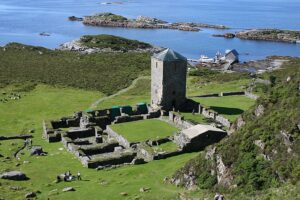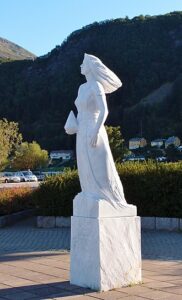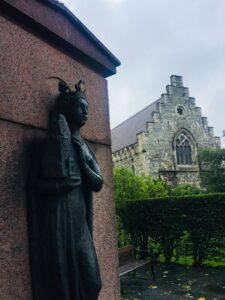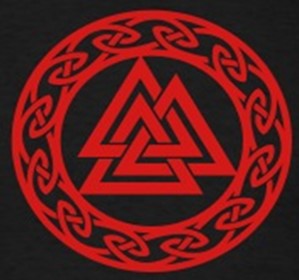
At the northwesternmost part of Sogn og Fjordane county lies Selje municipality, a quiet peninsula embracing a couple of small, rocky islands. One of those islands is Selja. At just one mile wide and with only five permanent residents (give or take a few goats), you would be excused to think there’s nothing significant or extraordinary about it. And yet, Selja Island played both a significant and extraordinary part in Norway’s religious history. Read on to find out more about the island that’s one of Norway’s most important pilgrimage destinations.
 Selja monastery has been considered one of the most sacred sites in Norway for more than 1000 years. The monastery is connected to the legend of St. Sunniva (10th century CE), who is the only female Norwegian saint, and was for a long time an important pilgrimage site in the country, second only to The Nidaros Cathedral in Trondheim. The historical context as well as the wild and enchanting surroundings still draw many visitors to the island and its monastery. It leaves a lasting impression on those who venture there.
Selja monastery has been considered one of the most sacred sites in Norway for more than 1000 years. The monastery is connected to the legend of St. Sunniva (10th century CE), who is the only female Norwegian saint, and was for a long time an important pilgrimage site in the country, second only to The Nidaros Cathedral in Trondheim. The historical context as well as the wild and enchanting surroundings still draw many visitors to the island and its monastery. It leaves a lasting impression on those who venture there.
The religious importance of the island of Selja starts with the legend of Saint Sunniva and the “Seljamen”, which supposedly happened during the 10th century CE. The legend is recorded in three different sources – Acta Sanctorum in Selio (1170 CE); Óláfs saga Tryggvasonar (c. 1190 CE by Oddr Snorrason, Iceland); and Flateyjarbók (14th century CE, Iceland) – but was first mentioned by Adam of Bremen (1040-1081 CE), who visited the island c. 1070 CE. Adam of Bremen’s visit took place 70-80 years after Olav Tryggvason, the first Christian king of Norway (r. 995-1000 CE), supposedly found the remains of St. Sunniva in the cave where she was buried in 996 CE.
 According to the legend, St. Sunniva was a Christian Irish princess who had to flee from her home. A heathen and violent king, possibly a Viking chief, sought to take control over her land and force her to marry him. The Irish princess escaped by boat, together with some of her people and her brother Alban. Alban was later mistakenly associated with the English St. Alban (3rd or 4th century CE), who the monastery later would be dedicated to. The boat was caught in rough weather and brought St. Sunniva and her company to the coast of Norway. They were stranded on Selja island, took shelter there in a cave, and settled on the previously uninhabited island.
According to the legend, St. Sunniva was a Christian Irish princess who had to flee from her home. A heathen and violent king, possibly a Viking chief, sought to take control over her land and force her to marry him. The Irish princess escaped by boat, together with some of her people and her brother Alban. Alban was later mistakenly associated with the English St. Alban (3rd or 4th century CE), who the monastery later would be dedicated to. The boat was caught in rough weather and brought St. Sunniva and her company to the coast of Norway. They were stranded on Selja island, took shelter there in a cave, and settled on the previously uninhabited island.
Norway was at that time ruled by Jarl Håkon Sigurðarson (r. c. 975-995 CE), a pagan king known for strongly opposing the Christianization of Norway. The people living on the mainland not far from Selja were skeptical about the new Christian settlers and sent word to Jarl Håkon accusing their new neighbors of stealing sheep. Jarl Håkon went to the island with a group of armed men with the intent of killing the Irish princess and the new inhabitants. St. Sunniva and her company hid in the cave and prayed to God for a miracle to protect them from the wrath of the heathens. Their prayers were heard. Stones fell from the mountain above blocking the entrance to the cave, stopping Jarl Håkon’s attack. Unfortunately, St. Sunniva and her followers were trapped inside the cave, and all died. Olav Tryggvason visited the cave later and found Sunniva’s body preserved, looking like she had only been sleeping. This was taken as a sign of her sacredness, and the island was soon established as an important pilgrimage site.

St. Sunniva became the patron saint of Bergen and the west coast of Norway. She is sometimes depicted next to Saint Olav (r. 1015-1028 CE), which may imply that she was at times also considered the patron saint of all Norway together with St. Olav. In most depictions, St. Sunniva is holding a stone, which symbolizes the stones that blocked the cave. These stones protected her and her people from being captured by the Norsemen, who opposed the introduction of the new Christian faith. The cult celebrating St. Sunniva was present in the caves on the island before a stone church and a Benedictine monastery were built in 1100 CE and dedicated to St. Alban. Selja became the first bishopric established on the west coast of Norway, but it was moved in 1170 CE to Bjørgvin (now Bergen). To this day, St. Sunniva, her brother, and their company are celebrated on 8 July, a day known as Seljumannamesse.
Excerpted from an article by Wanda Marcussen
World History Encyclopedia
August 2020
